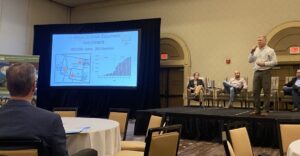Rocky Mountain Elk Foundation staffers recently joined scientists, practitioners and policymakers at the Corridors, Crossings and Connectivity Research Conference in California to share cutting-edge research and technical insights on wildlife migration and landscape connectivity. The event highlighted policy innovations tackling conservation challenges and featured experts and leaders from states, Tribes, federal agencies, NGOs, academia and the private sector across the United States.
RMEF Chief Conservation Officer Blake Henning and Dr. Heather Abernathy, RMEF wildlife research lead, attended the conference.
“While all the sessions were informative and worthwhile, my favorite was ‘Expanding Habitat Networks: Innovative Strategies for Private Land Conservation,’” said Abernathy. “Much of America’s wildlife relies on large, interconnected habitats, primarily managed by farmers, ranchers, and forest owners. As habitats are altered, collaboration between private landowners and other stakeholders becomes increasingly important for effective conservation and management. This session highlighted the NRCS-led ‘Working Lands for Wildlife’ approach, which provides a powerful framework for conserving working lands through cooperation and incentives.”
The session featured Montana rancher Jim Stone, who emphasized the value of working with private landowners as key stakeholders to create “partnerscapes” – collaborative networks of organizations, including government agencies, nonprofits, landowners and other stakeholders, working toward conservation goals at a landscape scale. Programs like the Regional Conservation Partnership Program are instrumental in building these networks by leveraging diverse expertise and resources to address natural resource concerns.
 An RMEF partner, Dr. David Naugle from the University of Montana and science advisor for Working Lands for Wildlife (see photo on right) presented the background for NRCS’s Framework for Conservation Action and highlighted the various tools and resources provided by NRCS to partners and the public. One included the new ‘Landscape Explorer’ tool, where Naugle emphasized that “knowledge is power, and this new tool puts both into the hands of landowners, scientists, and citizens. Seeing exactly what’s changed over time will inspire more people to work together to conserve the beautiful and valuable landscapes of the western U.S.”
An RMEF partner, Dr. David Naugle from the University of Montana and science advisor for Working Lands for Wildlife (see photo on right) presented the background for NRCS’s Framework for Conservation Action and highlighted the various tools and resources provided by NRCS to partners and the public. One included the new ‘Landscape Explorer’ tool, where Naugle emphasized that “knowledge is power, and this new tool puts both into the hands of landowners, scientists, and citizens. Seeing exactly what’s changed over time will inspire more people to work together to conserve the beautiful and valuable landscapes of the western U.S.”
Another RMEF partner, Dr. Jerod Merkle from the University of Wyoming, discussed how his and Dr. Matthew Kauffman’s research has advanced migration science for elk and other big game species. Merkle emphasized the importance of landowner collaboration by highlighting that most big game migrate through private land in the West. Their work, supported by RMEF, led to tools like a “fence prioritization tool” that helps landowners identify and modify fences most harmful to migrating wildlife, such as pronghorn, which often get entangled and perish.
To learn more about these efforts and join Jim Stone in creating partnerscapes, visit NRCS Regional Conservation Partnership Program.
RMEF is a staunch supporter of conserving wildlife migration corridors and expanding migration mapping. Over the last seven years, RMEF allocated more than $3.5 million, which leveraged $29.5 million in partner funding to support such efforts.
(Photo credit: Rocky Mountain Elk Foundation)
